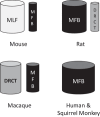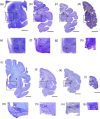Distribution of Serotonergic Transporter Innervation in the Nucleus Accumbens and Ventral Pallidum Is Highly Conserved Among Primates
- PMID: 40852912
- PMCID: PMC12376263
- DOI: 10.1002/cne.70083
Distribution of Serotonergic Transporter Innervation in the Nucleus Accumbens and Ventral Pallidum Is Highly Conserved Among Primates
Abstract
The nucleus accumbens (NAcc) and ventral pallidum (VP) are key nodes in the mesolimbic reward pathway that facilitate stimulus salience, including the regulation of social motivation and attachment. Primate species display variation in social behaviors, including different levels of impulsivity, bonding, and aggression. Previous research has implicated neuromodulation of the reward pathway in the differential expression of various social behaviors, suggesting that differences in neurotransmitter innervation may play a role in species-specific patterns. To explore this, we examined serotonergic innervation in the NAcc and VP among primates. We used stereology to quantify serotonin transporter-immunoreactive (SERT-ir) axon length density in the NAcc and VP of 13 primate species, including humans, great apes, and cercopithecid and platyrrhine monkeys. Our data show that serotonergic innervation density within both the NAcc and VP is highly conserved among species. This finding contrasts with our previous findings of higher levels of SERT-ir axons in the dorsal striatum of humans and great apes relative to monkeys, a human-specific increase in dopaminergic innervation within the NAcc and VP, and a human-specific increase of neuropeptide Y in the NAcc, highlighting the mosaic nature of innervation patterns among species.
Keywords: basal ganglia; human evolution; reward pathway; social behavior; striatum.
© 2025 The Author(s). The Journal of Comparative Neurology published by Wiley Periodicals LLC.
Conflict of interest statement
Dr. Patrick Hof and Dr. Mary Ann Raghanti are the Editorial Board members of CNE Journal and the co‐authors of this article. To minimize bias, they were excluded from all editorial decision‐making related to the acceptance of this article for publication. The authors declare no other conflicts of interest.
Figures





Similar articles
-
Serotonin innervation of the subthalamic nucleus in parkinsonian monkeys.Neurobiol Dis. 2025 Jul;211:106938. doi: 10.1016/j.nbd.2025.106938. Epub 2025 May 2. Neurobiol Dis. 2025. PMID: 40320179
-
Sources of Synaptic Input to Neurons in the Nucleus Accumbens Shell That Project to the Ventral Pallidum.J Comp Neurol. 2025 Aug;533(8):e70081. doi: 10.1002/cne.70081. J Comp Neurol. 2025. PMID: 40838534 Free PMC article.
-
Paraventricular Nucleus of the Thalamus Neurons That Project to the Nucleus Accumbens Show Enhanced c-Fos Expression During Early-Stage Cue-Reward Associative Learning in Male Rats.Eur J Neurosci. 2025 Jun;61(12):e70168. doi: 10.1111/ejn.70168. Eur J Neurosci. 2025. PMID: 40542605 Free PMC article.
-
Nucleus accumbens: a systematic review of neural circuitry and clinical studies in healthy and pathological states.J Neurosurg. 2022 Jul 22;138(2):337-346. doi: 10.3171/2022.5.JNS212548. Print 2023 Feb 1. J Neurosurg. 2022. PMID: 35901682
-
Serotonergic genes and suicide: a systematic review.Eur Neuropsychopharmacol. 2013 Oct;23(10):1125-42. doi: 10.1016/j.euroneuro.2013.03.013. Epub 2013 Jun 3. Eur Neuropsychopharmacol. 2013. PMID: 23742855
References
-
- Albert, P. R. , Sajedi N., Lemonde S., and Ghahremani M. H.. 1999. “Constitutive Gi2‐Dependent Activation of Adenylyl Cyclase Type II by the 5‐HT1A Receptor: Inhibition by Anxiolytic Partial Agonists.” Journal of Biological Chemistry 274, no. 50: 35469–35474. 10.1074/jbc.274.50.35469. - DOI - PubMed
-
- AnAge: The Animal Ageing and Longevity Database . n.d. “Human Ageing Genomic Resources.” Accessed June 30, 2025. https://genomics.senescence.info/species/index.html.
MeSH terms
Substances
Grants and funding
LinkOut - more resources
Full Text Sources

